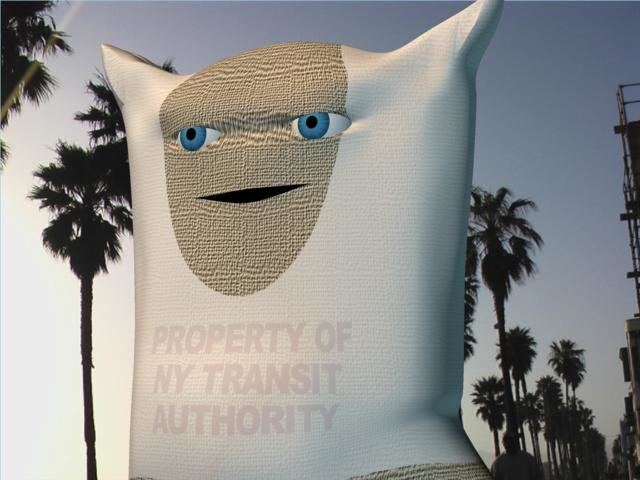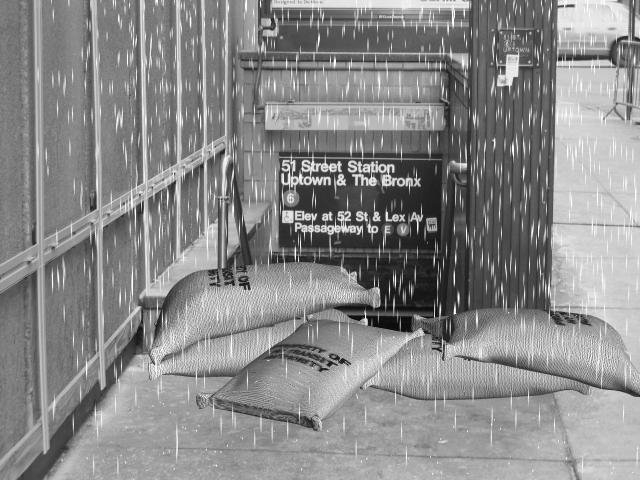-
Posts
74 -
Joined
-
Last visited
Content Type
Profiles
Forums
Events
Posts posted by Vance
-
-
I heard from a friend that Kraft was having a contest for 15-second commercials, and decided to do an animated one. I heard about the contest very late, so I didn't have much time to put it together. You can see the results at:
All comments pro and con are welcome.
-Vance
-
I'm working on a 5-minute short, and here's a look at one of my characters. I'm still revising the decaling and some of the splinage, but this is a very rough idea of where I'm going. He is composited with a real-life background, as he will be in the short.
In the picture above he has on a t-shirt (better decal to come later) in an unsuccessful attempt to cover up his "property of" stencil.
The short is about a couple of sandbags who run away from their jobs (keeping the NYC subways from flooding) and come out to California. Here they are back in NYC (in a B&W flashback):
All comments and suggestions welcome!
-Vance
-
It's really come a long way! Congratulations.
The cloth still looks just a little bit too springy to me. It has a little bit more bounce than real cloth does unless it contains rubber. Other than that, it is really getting there!
-Vance
-
Yep, back before envelopes with adhesive, you just folded the paper, dripped some wax on it and pressed your seal which both sealed the document and affixed your seal to it.
In any case, sealing wax, once used, was the most useless stuff on the planet. It was a little blob of melted wax you had to throw away. In both songs it is mentioned to show the triviality of the stuff the person is concerned with, in one case to show his sense of the wonderous, and the other to show how small-minded the guy is.
-Vance
-
Good work!
The one suggestion I have has to do with the eyes. If you look at real humans, you almost never see the top of the iris. It is almost always covered by the top eyelid, though you can occasionally see the bottom of the iris. The fact that we can see the top of your digital analogue's iris gives him a slightly psycho look. This is fine if that's what you are going for, but if you want to present yourself in a better light you might look at changing this.
-Vance
-
Very nice work! I particularly like her mouth opening slightly when the other character turns around. It sells the idea that something is going on in her head.
-Vance
-
-
I sent an email to Frank Silas and it seems that his Los Angeles HUG has been defunct for a few years. If you are interested in one in Los Angeles, I'm considering putting one together. If you are a San Diego person willing to drive up, you are also welcome. Email me at hugla@vancesoft.com if interested. If I get enough interest, I'll set up a meeting.
-Vance
User since the Playmation days
-
Thanks for finding Maquette, but this is not the model I'm looking for.
The model I'm looking for I believe is called Mannequin, did originally come with A:M, and it is a female form without hair. The original model was, as I recall, a dark brown color and a cloth-looking texture with some seamstress markings (dotted line stitching around the waist), but I changed the material to something more like chrome. Below is a picture of the model adapted as a robot.
-Vance

-
You were, of course, right. I went back through the tutorial and there was a step that I missed. Thanks for your help.
-Vance
-
It is definitely pre-2000. I've still got my 2000 and 2001 CDs and it is not on either of them. Thanks for checking, though.
-Vance
-
I did an animation using A:M about a decade ago, maybe longer. I had derived a robot character from a stock mannequin model included with A:M at the time (I believe it was called "mannequin"). Now, someone who saw my old animation is interested in me doing another one with the same character. Meanwhile, the machine all that work was on had a disk crash around 2000, and I don't have a copy of my robot model.
Can anyone help me locate a copy of the mannequin model? It also came with a walk cycle action, but I'm not sure that will be portable into the latest A:M. The Hash guys have made a lot of great changes to the product in the meantime. Being able to import just the model would be great.
-Vance
-
I'm doing something similar, and this information helped me to get one particle emitter behaving correctly. When I put a second copy of the particle emitter into the chor, I have not found a way to make the second copy of the particle emitter object's sprite emitter "rate" value change over time.
I tried doing what I thought I did the first time around, changing it in the shortcut to the particle material under the original particle emitter, not under the shortcut to the particle emitter in the chor (the latter shortcut doesn't have anywhere to change it). This changes the value, but does not create a key, and the new value is constant for the entire chor. I have clicked on the little lock that comes up when you change the value and I selected the clock icon (change value over time), but it does not make the value change over time. I've also tried changing the value under the Driver hierarchy, but this does not help either (under the driver there is no lock to select change value over time).
Of course I can create several separate particle emitter models and set each one up the same way, with only one of each in the chor, but I was curious if I was missing something that would allow multiple copies of the same emitter.
Also, I don't fully understand drivers. I looked in the tech reference and did not find much about how to create and use them, except as an artifact of other operations. I also searched the Tutorial forums and did not find anything that really goes into detail. Is there anyplace else I should be looking to dig deeper? Thanks!
-Vance
-
Name: Vance Gloster
Exercises Completed: Exercise 5
Date Completed: Jan. 5, 2006
Instructor: None
Here is a link to my completed exercise #5:
-Vance
-
Name: Vance Gloster
Exercise Completed: Exer 4
Date completed: 12-31-05
Here it is!
-Vance
-
Name: Vance Gloster
Exercise completed: Exercise 3
Date completed: 12-31-05
Here you go.
-Vance

-
Name: Vance Gloster
Exercises Completed: Exercise 2 Chorus Line
Date Completed: December 31, 2005
Instructor: None
Remarks/Suggestions for Improvement: When I first tried this I got a random pattern of beige lines on the carpet. This was the ground automatically created as part of the coreography interfering with the red carpet that is part of the stage. Once I deleted the ground, the beige lines disappeared. Either the instructions should say to delete the ground or to be careful to place the stage above the ground instead of at the same level.
It would not let me upload this as an attachment. Here's a link to it on my site.
-Vance
-
Name: Vance Gloster
Exercise Completed: Exercise 1
Date Completed: 12/30/05
Instructor: none
I have been using Hash off and on products since they were selling Playmation, before A:M (back when dinosaurs roamed the earth). I decided that going through all the exercises should be a good way to get up to speed on the latest version. Here's my first project:
-Vance

-
Assuming a cylinder, or similar regular solid, if a is the factor the Z axis is being squashed or stretched (let's say .9) both X and Y should be multiplied by a factor of 1/SQRT(a) to keep equal volume. This is a good approximation for things that are roughly cylindrical, such as torsos and arms and legs, and it is precisely correct for rectangular solids like a building or a brick.
-
The goal of squash and stretch is equal volume at the extremes. Here is how to calculate it:
Volume = n * X * Y * Z
where n is a constant depending on the shape. It is 1 for a rectangular solid, and pi / 4 for a cylinder. You want volume to stay constant when you diddle one of the coordinates:
Volume = n * aX * bY * bZ
where a is the factor for the coordinate you want to diddle. If you are squashing it might be .9 (90%). b is the factor you will multiply the other two dimensions by to keep equal volume. Fairly simple algebra shows that b is the square root of 1/a, so if a is .9, then b is approximately 1.0541 or 105.41%.
Note: this works exactly for regular solids, but you may have to do a different calculation for a more irregular object, such as Pistol Pete's belly, which is a great example of squash and stretch in the old Disney shorts.
-
You also need to know the focal length and the distance. If you know these, along with the shape and position within the frame (and the original shape) it should be possible to figure out the relative position of the camera and the rotational angle of the object.
-
As far as I know A:M is not aware of multi-processor systems. If you are running A:M on a multiprocessor Windows machine, you can manually make A:M use two processors in rendering.
Launch two instances of A:M, then bring up Windows Task Manager (hit Ctrl-Alt-Del) and use the Set Affinity button to assign each A:M process to a different processor. Each instance of A:M can be used to render different frames.
Good luck!
-
A:M was amazing a decade ago when I got started using it, but unlike most other software products it is even better and easier to use today than it was back then. Hash listened to the thousands of users, and has continuously improved the product both functionally and in the area of usability.
In a couple of hours with the tutorial you can create an animation of a group of diverse characters in a kick line. If you are experienced, you can explore advanced features such as caustics, dynamics and radiosity. It has a depth that you can go as far as you want with.
You can create animated shorts, commercials, or (preferably with a few friends' help) even full-length features. You can also create computer generated images to composite with live action (like Gollum in LOTR). It has a renderer that lets you create animations that look like normal 2D animation, so you can do just about anything you would need to. The character animation features are as good as the most expensive programs, and make it possible to create very lifelike character performances.
I've done some shorts and some short transitions for a local television show, and the output it produced was professional quality all the way. Now all I need is more hours in the day to be able to get my next project done faster!
-Vance Gloster
Arcadia, CA
-
Ken, if you are doing A:M classics, it might be fun to also post "Gecko", which I think was also Allan, in light of the popularity of the Geico ads.
-Vance




a Walk in the park
in Work In Progress / Sweatbox
Posted
Much improved; you're getting some character into the guy. And I love the specatator.
What still bothers me about him is that his swaying left and right seems almost a greater distance at the shoulder than the distance his feet move forward. For me, this makes it look like his foot movement is an artifact of the swaying rather than the swaying being an artifact of the foot movement. If you are going for a silly cartoony look this may be OK, but I think he would be more believable if the largest motion in walking was the foot movement. Also the swaying seems a little mechanical, so perhaps you can have it lead or lag the other motions a bit to loosen it up.
Keep up the good work!
-Vance